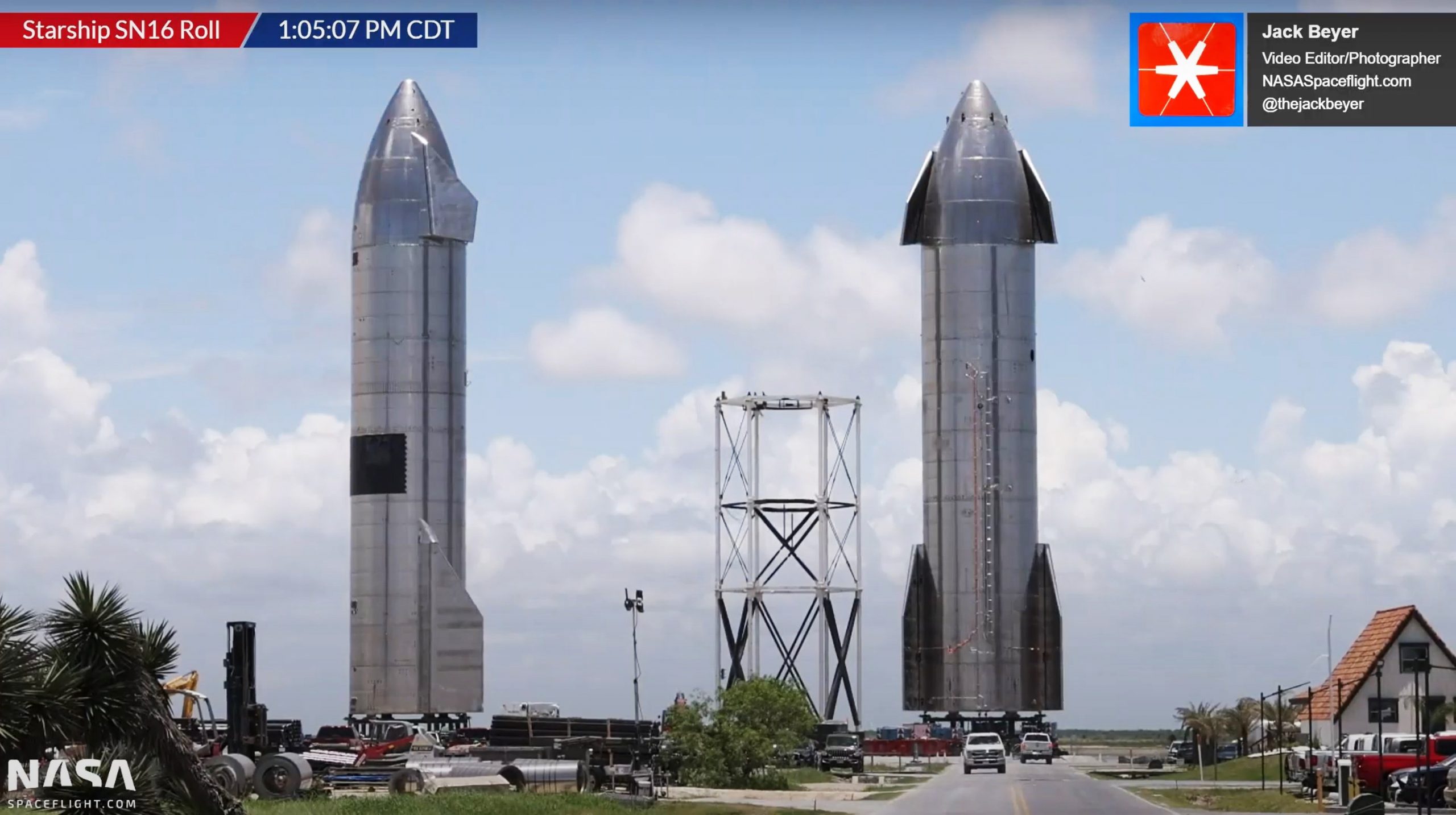
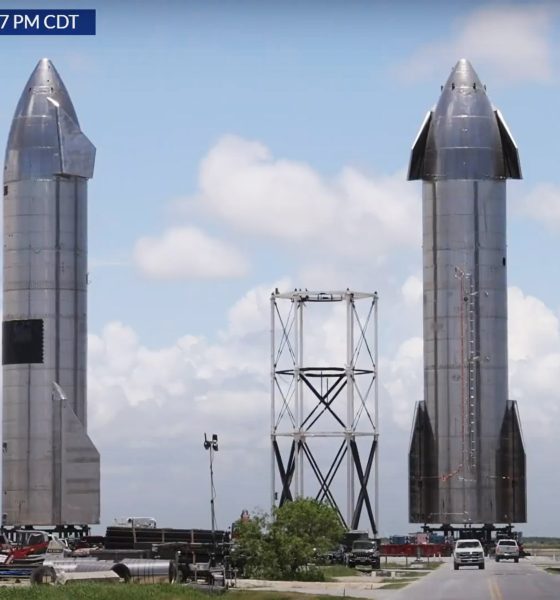
News
[Update: not so fast…] SpaceX retires brand new Starship to focus on orbital launch buildup
SpaceX has moved its newest finished Starship straight from its Boca Chica, Texas factory to a nearby ‘rocket garden,’ all but guaranteeing an early retirement.
Built as the first of several planned backups to Starship SN15, which debuted a number of significant upgrades in April and May, it appears that Starship serial number 16 (SN16) has been retired to a display stand after its only sibling became the first full-size prototype to successfully survive a launch and landing on May 5th. SN16 actually reached its full height before SN15 lifted off and was more or less complete by May 10th. Since then, the prototype has remaining more or less untouched, seemingly waiting for SpaceX to decide its fate in lieu of Starship SN15’s major success.
Ultimately, with SN16 now sitting side by side with SN15 at what will likely become a sort of open-air SpaceX museum, it appears that the company has made up its mind.
Once SN15 touched down, safed itself, and remained standing after a near-flawless 10 km (6.2 mi) test flight, questions about Starship SN16’s fate almost immediately arose. From the outside looking in, replicating that spectacular success was judged a logical next step by many in light of the four variously unsuccessful Starship launches that closely preceded it. If SpaceX could land SN15 and then successfully recover an entirely separate Starship weeks later, it would all but eliminate the possibility that – much like several different failure modes popped up on SN8 through SN11 – the first total success was a fluke.
Given that SN16 was quite literally completed within days of SN15’s launch and landing, it seemed an almost foregone conclusion that SN16 would fly. For a few weeks, it even looked possible that SpaceX would attempt to reuse Starship SN15. However, SpaceX appeared to decide against reuse and rolled its first flight-proven full-size Starship from the pad to a plot of land expected to host a future ‘garden’ for retired SpaceX rockets.
After its three intact flight-proven Raptor engines – valuable in their own right – were removed, Starship SN15 was seemingly retired around May 26th. Three weeks later, SN16 has (quite literally, to an extent) followed in SN15’s footsteps, bowing to an apparently virulent desire within (or at least atop) SpaceX to launch Starship into space and orbit as quickly as possible. From that perspective, assuming enough data was gathered by Starship SN15 to encourage significant confidence that its survival wasn’t an ‘accidental success,’ reusing Starship SN15 or flying Starship SN16 would only really benefit a line of prototypes that had just made itself obsolete.
Much like Starship SN15 debuted “hundreds of improvements” across the board, CEO Elon Musk revealed that Starship SN20 would also involve a “major technology [revision]” to produce the first prototypes with full heat shields, a stage separation mechanism, vacuum-optimized Raptor engines, and more. In fact, that process may still be ongoing, which could explain why SpaceX has yet to begin assembling Starship SN20 – various subsections and components of which have already been completed in Boca Chica.
Confirmed by Musk in March, SpaceX has been working towards a target of no later than July 2021 for Starship’s first orbital test flight. Given that Starship SN20 has yet to enter the assembly phase and that Super Heavy “Booster 2” (BN3) will be the first of its kind and likely need to pass several major tests on its own, July is no longer within reach. Of course, an orbital launch attempt anytime in 2021 would still be a staggering achievement for SpaceX, beating the likes of Vulcan Centaur, New Glenn, and Ariane 6 to the punch despite Starship’s superior performance, unprecedented design challenges, and grander ambitions.

News
Tesla’s most affordable car is coming to the Netherlands
The trim is expected to launch at €36,990, making it the most affordable Model 3 the Dutch market has seen in years.
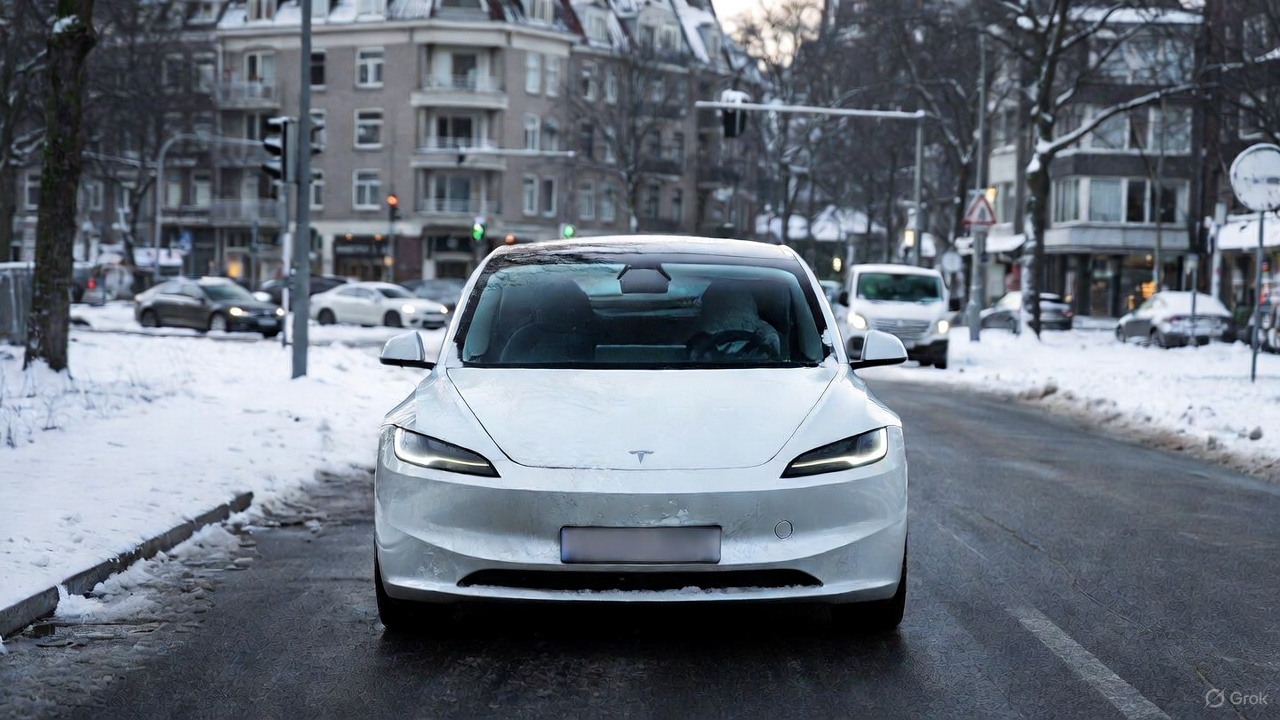
Tesla is preparing to introduce the Model 3 Standard to the Netherlands this December, as per information obtained by AutoWeek. The trim is expected to launch at €36,990, making it the most affordable Model 3 the Dutch market has seen in years.
While Tesla has not formally confirmed the vehicle’s arrival, pricing reportedly comes from a reliable source, the publication noted.
Model 3 Standard lands in NL
The U.S. version of the Model 3 Standard provides a clear preview of what Dutch buyers can expect, such as a no-frills configuration that maintains the recognizable Model 3 look without stripping the car down to a bare interior. The panoramic glass roof is still there, the exterior design is unchanged, and Tesla’s central touchscreen-driven cabin layout stays intact.
Cost reductions come from targeted equipment cuts. The American variant uses fewer speakers, lacks ventilated front seats and heated rear seats, and swaps premium materials for cloth and textile-heavy surfaces. Performance is modest compared with the Premium models, with a 0–100 km/h sprint of about six seconds and an estimated WLTP range near 550 kilometers.
Despite the smaller battery and simpler suspension, the Standard maintains the long-distance capability drivers have come to expect in a Tesla.
Pricing strategy aligns with Dutch EV demand and taxation shifts
At €36,990, the Model 3 Standard fits neatly into Tesla’s ongoing lineup reshuffle. The current Model 3 RWD has crept toward €42,000, creating space for a more competitive entry-level option, and positioning the new Model 3 Standard comfortably below the €39,990 Model Y Standard.
The timing aligns with rising Dutch demand for affordable EVs as subsidies like SEPP fade and tax advantages for electric cars continue to wind down, EVUpdate noted. Buyers seeking a no-frills EV with solid range are then likely to see the new trim as a compelling alternative.
With the U.S. variant long established and the Model Y Standard already available in the Netherlands, the appearance of an entry-level Model 3 in the Dutch configurator seems like a logical next step.
News
Tesla Model Y is still China’s best-selling premium EV through October
The premium-priced SUV outpaced rivals despite a competitive field, while the Model 3 also secured an impressive position.
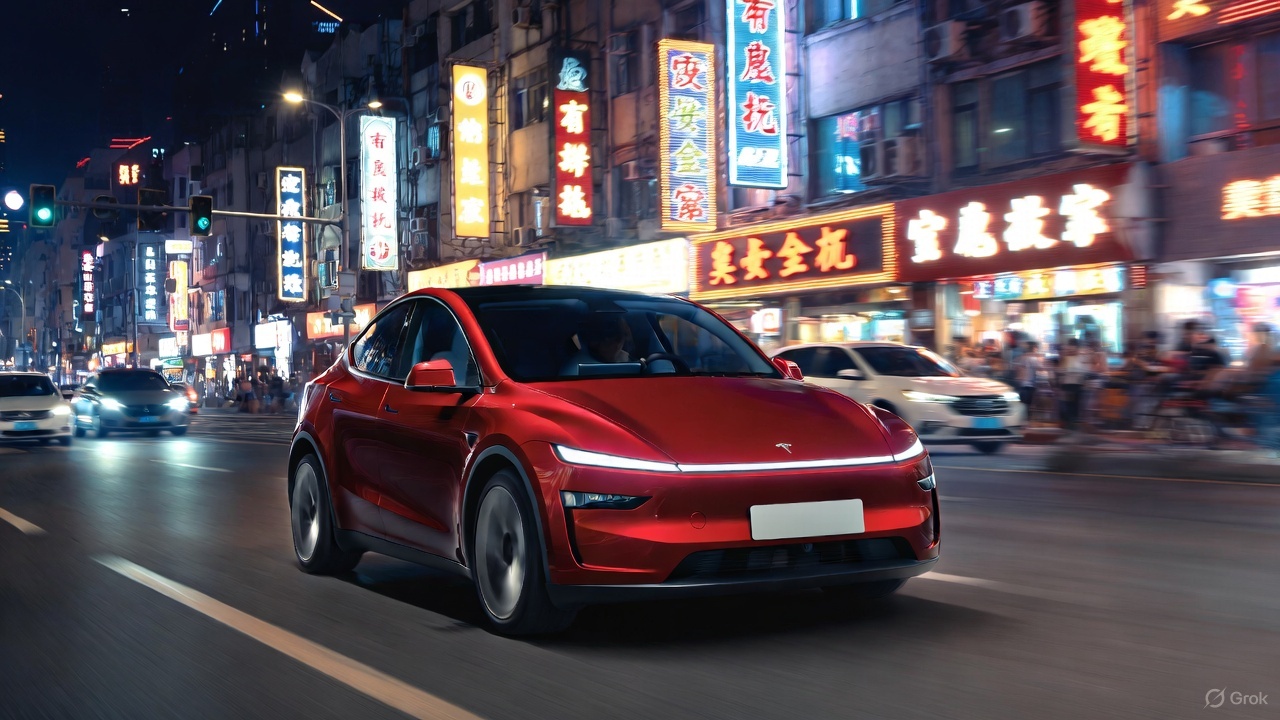
The Tesla Model Y led China’s top-selling pure electric vehicles in the 200,000–300,000 RMB segment through October 2025, as per Yiche data compiled from China Passenger Car Association (CPCA) figures.
The premium-priced SUV outpaced rivals despite a competitive field, while the Model 3 also secured an impressive position.
The Model Y is still unrivaled
The Model Y’s dominance shines in Yiche’s October report, topping the chart for vehicles priced between 200,000 and 300,000 RMB. With 312,331 units retailed from January through October, the all-electric crossover was China’s best-selling EV in the 200,000–300,000 RMB segment.
The Xiaomi SU7 is a strong challenger at No. 2 with 234,521 units, followed by the Tesla Model 3, which achieved 146,379 retail sales through October. The Model Y’s potentially biggest rival, the Xiaomi YU7, is currently at No. 4 with 80,855 retail units sold.

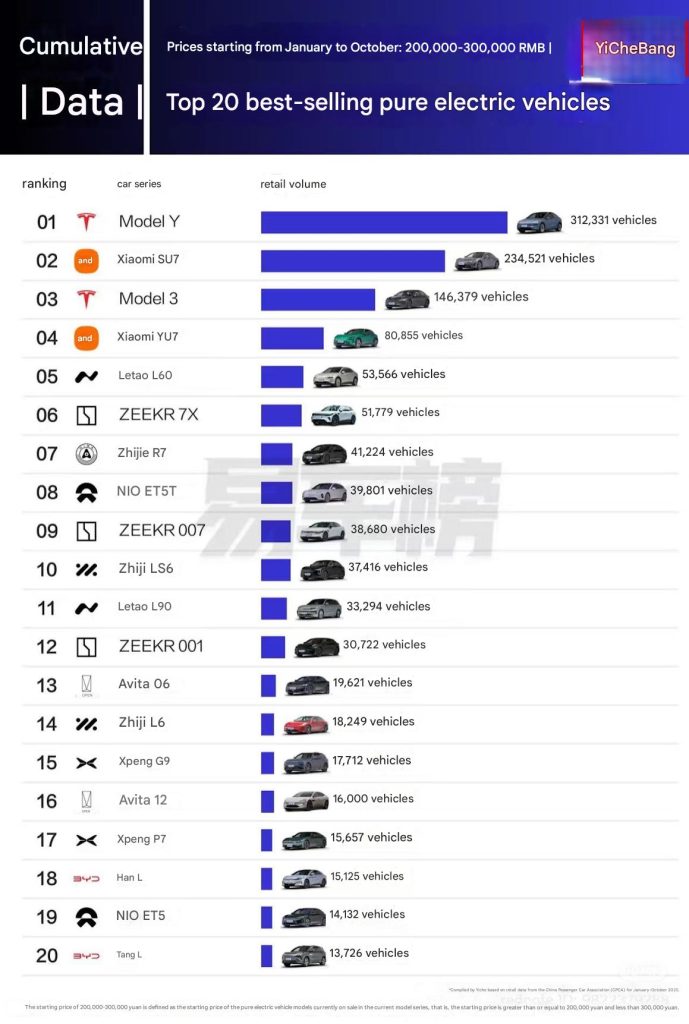
Efficiency kings
The Model 3 and Model Y recently claimed the top two spots in Autohome’s latest real-world energy-consumption test, outperforming a broad field of Chinese-market EVs under identical 120 km/h cruising conditions with 375 kg payload and fixed 24 °C cabin temperature. The Model 3 achieved 20.8 kWh/100 km while the Model Y recorded 21.8 kWh/100 km, reaffirming Tesla’s efficiency lead.
The results drew immediate attention from Xiaomi CEO Lei Jun, who publicly recognized Tesla’s advantage while pledging continued refinement for his brand’s lineup.
“The Xiaomi SU7’s energy consumption performance is also very good; you can take a closer look. The fact that its test results are weaker than Tesla’s is partly due to objective reasons: the Xiaomi SU7 is a C-segment car, larger and with higher specifications, making it heavier and naturally increasing energy consumption. Of course, we will continue to learn from Tesla and further optimize its energy consumption performance!” Lei Jun wrote in a post on Weibo.
Elon Musk
SpaceX’s Starship program is already bouncing back from Booster 18 fiasco
Just over a week since Booster 18 met its untimely end, SpaceX is now busy stacking Booster 19, and at a very rapid pace, too.
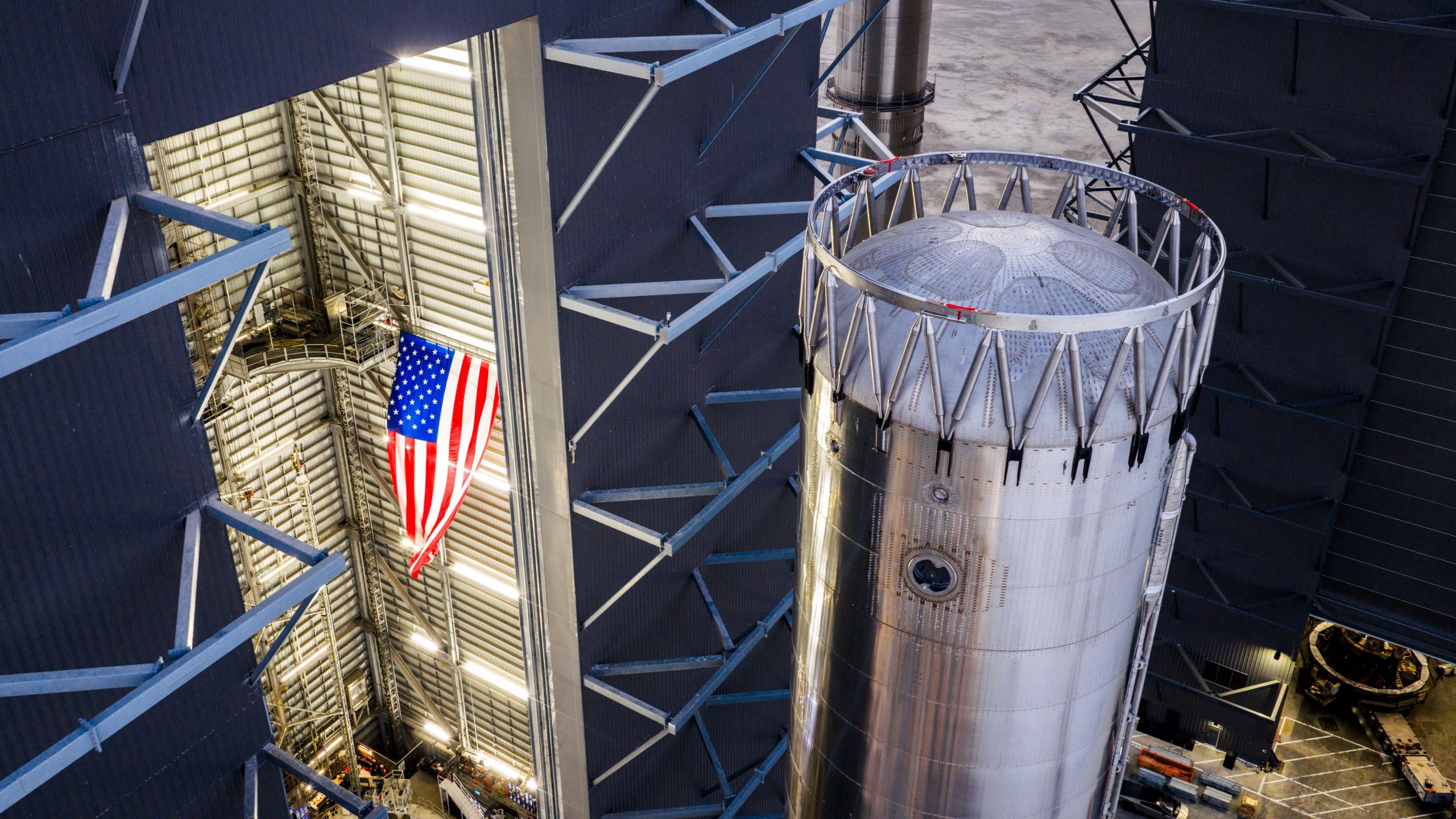
SpaceX is already bouncing back from the fiasco that it experienced during Starship Booster 18’s initial tests earlier this month.
Just over a week since Booster 18 met its untimely end, SpaceX is now busy stacking Booster 19, and at a very rapid pace, too.
Starship V3 Booster 19 is rising
As per Starbase watchers on X, SpaceX rolled out the fourth aft section of Booster 19 to Starbase’s MegaBay this weekend, stacking it to reach 15 rings tall with just a few sections remaining. This marks the fastest booster assembly to date at four sections in five days. This is quite impressive, and it bodes well for SpaceX’s Starship V3 program, which is expected to be a notable step up from the V2 program, which was retired after a flawless Flight 11.
Starship watcher TankWatchers noted the tempo on X, stating, “During the night the A4 section of Booster 19 rolled out to the MegaBay. With 4 sections in just 5 days, this is shaping up to be the fastest booster stack ever.” Fellow Starbase watcher TestFlight echoed the same sentiments. “Booster 19 is now 15 rings tall, with 3 aft sections remaining!” the space enthusiast wrote.
Aggressive targets despite Booster 18 fiasco
SpaceX’s V3 program encountered a speed bump earlier this month when Booster 18, just one day after rolling out into the factory, experienced a major anomaly during gas system pressure testing at SpaceX’s Massey facility in Starbase, Texas. While no propellant was loaded, no engines were installed, and no one was injured in the incident, the unexpected end of Booster 18 sparked speculation that the Starship V3 program could face delays.
Despite the Booster 18 fiasco, however, SpaceX announced that “Starship’s twelfth flight test remains targeted for the first quarter of 2026.” Elon Musk shared a similar timeline on X earlier this year, with the CEO stating that “ V3 is a massive upgrade from the current V2 and should be through production and testing by end of year, with heavy flight activity next year.”
Considering that Booster 19 seems to be moving through its production phases quickly, perhaps SpaceX’s Q1 2026 target for Flight 12 might indeed be more than feasible.









